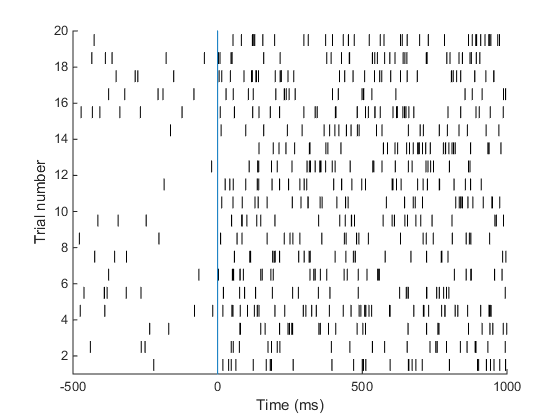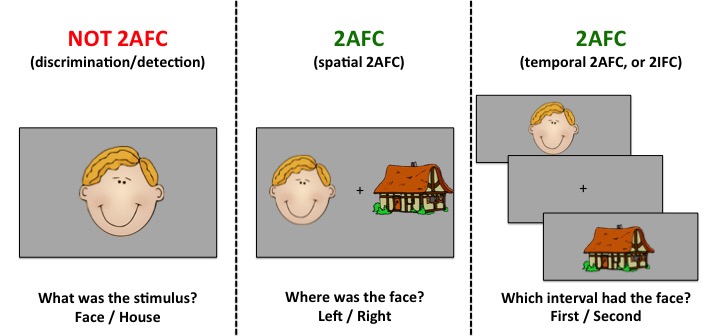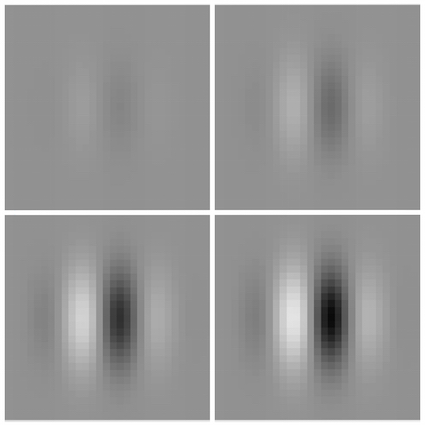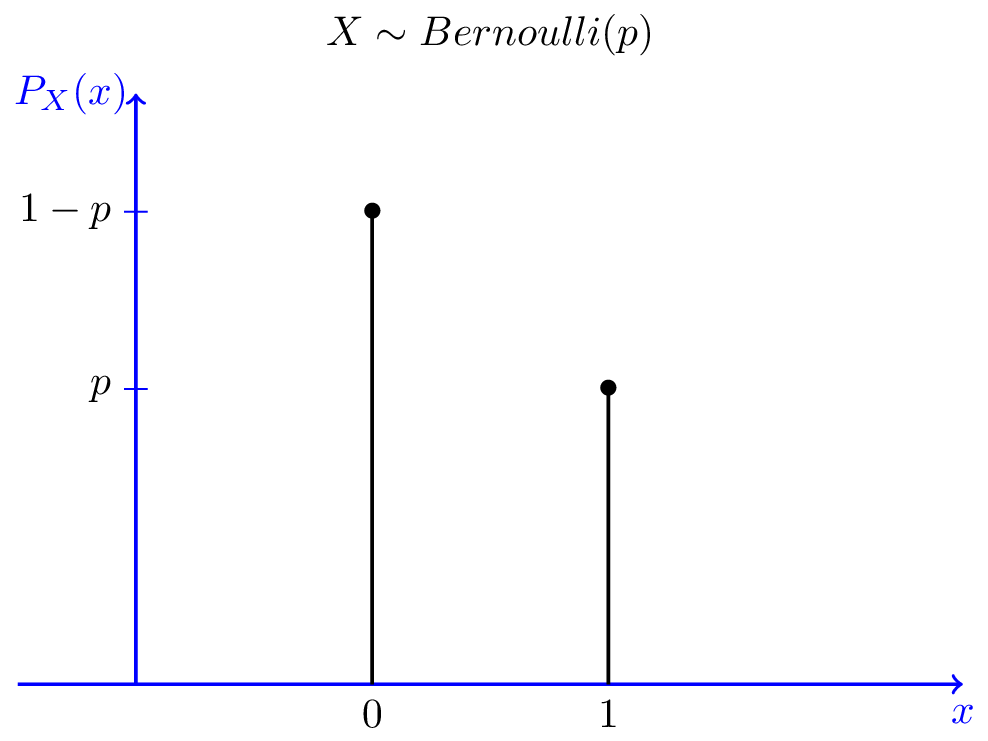Generalised Linear Model
Benedikt Ehinger
March 21st, 2018
Slides & my Presentation style
Click this link to add notes to the slides
this adds ?showNotes=true to the file
You can download the pdf or print them yourself:
click this link for pdf printable (use google chrome)
click this link for pdf printable + notes
HTML is best viewed in chrome
What we want to be able to analyse
 Neural firing is poisson-like 1,2,3,4 .. spike / s => Discrete outcome!
Neural firing is poisson-like 1,2,3,4 .. spike / s => Discrete outcome!
 Many experiments have two outcomes (more example to come)
Many experiments have two outcomes (more example to come)
Data is only 0 and 1, we want to estimate probabilities
GLMs allow us to model outcomes from distributions other than the normal distribution.
Overview
- Binary Outcomes
- Example
- Logistic regression
- Units, odds, relative risks
- Interpretation of coefficients
- Checking the model
- Inference
- Poisson Regression
- GLMs
- Assumptions
Example tasks with binomial data

Decoding: Is it a face or a house? Based on BOLD/EEG data
Will the patient survive?

Did you see a grating?
Bernoulli vs Binomial
Bernoulli
- A single throw of a coin
- Will the coin be heads or tails?

Binomial
- Sum over multiple Bernoulli throws
- How many heads will I get (out of N throws)

An example with a continuos variable
- Task: Do you observe a grating?
- Research Question: What is the minimum contrast to reliably (>25%) detect a grating?

n.trial =150
n.contrastLevels=12The Data

What is the probability to detect the target?

Let’s try linear regression

Truncating everything smaller 0 / larger 1:

A contrast of ~16% will be rejected in 100% of cases.
A strong statement!A better fit

transforming y
 An alternative view, same data but different y-axis
An alternative view, same data but different y-axis
logit & inv.logit

From \([0, 1]\) to \([-\infty, +\infty]\)
\[ x = log(\frac{p}{1-p})\]

From \([-\infty, +\infty]\) to \([0, 1]\)
\[ p = \frac{1}{1+e^{-x}}\]

Overview
- Binary Outcomes
- Example
- Logistic regression
- Units, odds, relative risks
- Interpretation of coefficients
- Checking the model
- Inference
- Poisson Regression
- GLMs
- Assumptions
logistic regression

\(y = invlogit(X\beta + e)\) <=> \(logit(y) = X\beta + e\)
\[y = g^-1( X\beta + e) \]
yes! that is the g from GLM
We call this logistic regression
Running a logistic regression in R
res = glm(formula = response ~ 1 + contrast, data=d,family=binomial)
summary(res)##
## Call:
## glm(formula = response ~ 1 + contrast, family = binomial, data = d)
##
## Deviance Residuals:
## Min 1Q Median 3Q Max
## -2.9298 -0.4171 -0.1217 0.5597 2.5579
##
## Coefficients:
## Estimate Std. Error z value Pr(>|z|)
## (Intercept) -5.73617 0.91880 -6.243 4.29e-10 ***
## contrast 0.10014 0.01556 6.437 1.22e-10 ***
## ---
## Signif. codes: 0 '***' 0.001 '**' 0.01 '*' 0.05 '.' 0.1 ' ' 1
##
## (Dispersion parameter for binomial family taken to be 1)
##
## Null deviance: 205.78 on 149 degrees of freedom
## Residual deviance: 103.39 on 148 degrees of freedom
## AIC: 107.39
##
## Number of Fisher Scoring iterations: 6the interplay of our two predictors

Changing Intercept \(\beta_0\)

Changing Slope \(\beta_1\)
Overview
- Binary Outcomes
- Example
- Logistic regression
- Units, odds, relative risks
- Interpretation of coefficients
- Checking the model
- Inference
- Poisson Regression
- GLMs
- Assumptions
What are the units on the y-axis / the coefficients?
 \[invlogit = \frac 1 {1+e^{-x}}\]
\[invlogit = \frac 1 {1+e^{-x}}\]
\[logit = log(\frac p {1-p}) = log(odds)\]
What are odds?
Odds are a somewhat unintuitive quantity: \[p(coxi==nerd) = 0.75\]
\[odds(coxi==nerd) = \frac{p(coxi==nerd)}{p(coxi \neq nerd)} = \frac{0.75}{1-0.75} = \frac{0.75}{0.25} = 3\]
In words: the odds for an cogsci to be a nerd are 3 to 1
For 3 nerd coxis you will find 1 non-nerdA closer look at the logit function
\[odds = \frac{p}{1-p}\] (\(odds \in [0,+\infty]\), halfway there)
taking the log()
\[log(odds) = logit = log(\frac{p}{1-p})\]
This is a mapping from \(p \in [0,1]\) to \(logit(p) \in [-\infty +\infty]\)
Background: Differences in probabilities, relative risk vs risk difference
- \(p(coxi==nerd) = 0.75\)
- \(p(psycho==nerd) = 0.6\)
- Risk Difference: 0.75 - 0.6 => coxis are 15 percentage points more likely to be nerds
- Relative Risk: \(\frac{0.75}{0.6} = 1.25\) => Coxis are 25% more likely to be nerds
- Relative Risks are intuitive but non symmetric:
- \(\frac{p(X)}{p(Y)} = \frac{0.99}{0.98} = 1.01\) => X is 1% more likely than Y
- \(\frac{p(\neg X)}{p(\neg Y)} = \frac{0.01}{0.02} = 0.5\) => not X is 50% more likely than not Y
The problem with relative risks
 p(X|contrast=60) / p(X|contrast=50) = 0.57/0.33 = 1.73
p(X|contrast=60) / p(X|contrast=50) = 0.57/0.33 = 1.73
p(X|contrast=80) / p(X|contrast=70) = 0.91/0.78 = 1.17
An contrast increase of 10 on X is not a constant increase in the relative risks.
Overview
- Binary Outcomes
- Example
- Logistic regression
- Units, odds, relative risks
- Interpretation of coefficients
- Checking the model
- Inference
- Poisson Regression
- GLMs
- Assumptions
The constant / Intercept
TLDR; \(\beta_0\) = log-odds if everything else is 0.- \(\beta_0\)<0: \(p = invlogit(-) < 0.5\)
- \(\beta_0\)==0: \(p = invlogit(0) = 0.5\)
- \(\beta_0\)>0: \(p = invlogit(+) > 0.5\)
- \(y(x) = invlogit(\beta_0 + \beta_1 x)\)
- \(y(x) = \frac{1}{1 + e^{-(\beta_0 + \beta_1 x)}}\)
- \(y(x=0) = \frac{1}{1 + e^{-\beta_0}}\)
In our example
coef(glm(response~contrast,data=d,family=binomial))[1] # log-odds## (Intercept)
## -5.736166invlogit(coef(glm(response~contrast,data=d,family=binomial))[1]) # probability## (Intercept)
## 0.003216738
Interpreting the slope
TLDR; \(\beta_1\) = how much a change of x+1 increases the log(odds-ratio)
\[log(odds) = \color{red}{logit(\hat y(x))} = \beta_0 + \beta_1 x \]
An increase by \(1*\beta_1\) : \(\color{green}{logit(\hat y(x+1))} = \beta_0 + \beta_1 (x+1)\)
Taking the difference:
\[\color{green}{logit(\hat y(x+1))} - \color{red}{logit(\hat y(x))} = \color{green}{\beta_0 + \beta_1 (x+1)} - (\color{red}{\beta_0 + \beta_1 x} )= \beta_1 \]
Using the log-rule on the left side (\(log(odds_a) - log(odds_b) = log(\frac {odds_a} {odds_b} )\))
\[\beta_1 = \color{green}{logit(\hat y(x+1))} - \color{red}{logit(\hat y(x))} = \color{green}{log(odds(x+1)} - \color{red}{log(odds(x))}= log(\color{blue}{\frac{odds(x+1)}{odds(x)}})\]
\[\beta_1 = log(\color{blue}{odds-ratio})\]
What are odds-ratios?
\[odds(coxi==nerd) = 3\]
\[odds(psycho==nerd) = 1.5\]
\[odds-ratio = \frac{3}{1.5} = 2\]
The odds that coxis are nerds are 2x as high than the odds that psychology students are nerds.
(remember relative risk: Coxis are 1.25 as likely than psychology students to be nerds)
\[e^{\beta_1} = odds-ratio( y(x)/y(x+1))\]
The odds that you will succeed are \(e^{beta}\) higher at \(y(x+1)\) than \(y(x)\)
Back to the example
co = coef(glm(response~contrast,data=d,family=binomial)) # log-odds ratio
co["contrast"]## contrast
## 0.1001421exp(co["contrast"]) # odds ratio## contrast
## 1.105328With a step of 1, the odds change by ~1.1
With a step of 10, the odds change by ~2.7
Coming back to relative risks
Interpretation of odds ratios is difficult and unintuitive. I always try to give examples, i.e. what is the relative risks between two outcomes.
What is the relative risk between contrast = 50 and contrast = 80?
a = invlogit(co["(Intercept)"]+co["contrast"] * 80)
b = invlogit(co["(Intercept)"]+co["contrast"] * 50)we have ~280% more successes at contrast = 80 than at contrast = 50
Intermediate Summary
\[y = g^-1(\beta X + e) \]
\(y = invlogit(\beta X + e)\) <=> \(logit(y) = \beta X + e\)
- Binary data (0/1, True/False)
- Units are log(odds)
- one of many link-functions of GLMs
- It is possible to use other functions that map \(p \in [0,1]\) to \(logit(p) \in [-\infty +\infty]\), e.g. probit (cumulative normal). But the units are not as easily interpretable as odds (!)
Overview
- Binary Outcomes
- Example
- Logistic regression
- Units, odds, relative risks
- Interpretation of coefficients
- Checking the model
- Inference
- Poisson Regression
- GLMs
- Assumptions
Residuals
res = glm(formula = response ~ 1 + contrast, data=d,family=binomial)
summary(res)##
## Call:
## glm(formula = response ~ 1 + contrast, family = binomial, data = d)
##
## Deviance Residuals:
## Min 1Q Median 3Q Max
## -2.9298 -0.4171 -0.1217 0.5597 2.5579
##
## Coefficients:
## Estimate Std. Error z value Pr(>|z|)
## (Intercept) -5.73617 0.91880 -6.243 4.29e-10 ***
## contrast 0.10014 0.01556 6.437 1.22e-10 ***
## ---
## Signif. codes: 0 '***' 0.001 '**' 0.01 '*' 0.05 '.' 0.1 ' ' 1
##
## (Dispersion parameter for binomial family taken to be 1)
##
## Null deviance: 205.78 on 149 degrees of freedom
## Residual deviance: 103.39 on 148 degrees of freedom
## AIC: 107.39
##
## Number of Fisher Scoring iterations: 6Excourse Likelihood function
Deviance / Residuals
\(\theta_i = \hat{y}_i = invlogit(\beta X)\)
- \(LL(y|\hat y) =\) loglikelihood \(=log(\prod{\hat{y_i}^{y_i} (1-\hat{y_i})^{(1-y_i)}})\)
- for a single data point simplifies to
- if \(y_i = 1\): \(log(\hat{y_i})\) if \(y_i = 0\): \(log(1-\hat{y_i})\)
- Deviance Residuals: \(d_i = s_i\sqrt{-2LL(y_i|\hat y_i)}\) \(s_i = 1\) if \(y_i = 1\), \(s_i = -1\) if \(y_1 = 0\)
- Intuition words: deviance is a measure of how well the model fits a data point.

Null & Residual Deviance
res = glm(formula = response ~ 1 + contrast, data=d,family=binomial)
summary(res)##
## Call:
## glm(formula = response ~ 1 + contrast, family = binomial, data = d)
##
## Deviance Residuals:
## Min 1Q Median 3Q Max
## -2.9298 -0.4171 -0.1217 0.5597 2.5579
##
## Coefficients:
## Estimate Std. Error z value Pr(>|z|)
## (Intercept) -5.73617 0.91880 -6.243 4.29e-10 ***
## contrast 0.10014 0.01556 6.437 1.22e-10 ***
## ---
## Signif. codes: 0 '***' 0.001 '**' 0.01 '*' 0.05 '.' 0.1 ' ' 1
##
## (Dispersion parameter for binomial family taken to be 1)
##
## Null deviance: 205.78 on 149 degrees of freedom
## Residual deviance: 103.39 on 148 degrees of freedom
## AIC: 107.39
##
## Number of Fisher Scoring iterations: 6Null Deviance\(^2\): \(2(LL(M_{saturated}) - LL(M_0))\)
Residual Deviance\(^2\): \(2(LL(M_{saturated}) - LL(M_1))\)
Overview
- Binary Outcomes
- Example
- Logistic regression
- Units, odds, relative risks
- Interpretation of coefficients
- Checking the model
- Inference
- Poisson Regression
- GLMs
- Assumptions
Model comparison
m0 = glm(response~1 ,data=d,family=binomial)
m1 = glm(response~1 + contrast,data=d,family=binomial)
anova(m0,m1,test='LRT')## Analysis of Deviance Table
##
## Model 1: response ~ 1
## Model 2: response ~ 1 + contrast
## Resid. Df Resid. Dev Df Deviance Pr(>Chi)
## 1 149 205.78
## 2 148 103.39 1 102.39 < 2.2e-16 ***
## ---
## Signif. codes: 0 '***' 0.001 '**' 0.01 '*' 0.05 '.' 0.1 ' ' 1The predictor contrast is highly significant
Which is (in the case of one predictor) exactly the same as:
Null Deviance - Residual Deviance: \((LL(M_{1}) - LL(M_{0}))\)
Overview
- Binary Outcomes
- Example
- Logistic regression
- Units, odds, relative risks
- Interpretation of coefficients
- Checking the model
- Inference
- Poisson Regression
- GLMs
- Assumptions
Poisson Regression
Count-data has an average rate per time unit: \(\lambda\)
- Matings of animals per year (Biology)
- How many/much seizures/headaches/pain per week (Medicine)
- How many spikes per 10ms bin (Neuroscience)
- How many eve-movements per minute/trial (CogPsy)

(fictional) Example: Poisson Regression

fitting in R and Interpretation
m1 = glm(data=df.pois,formula = fixations~coffee*tea,family=poisson)
summary(m1)##
## Call:
## glm(formula = fixations ~ coffee * tea, family = poisson, data = df.pois)
##
## Deviance Residuals:
## Min 1Q Median 3Q Max
## -2.73861 -0.69280 0.06776 0.59125 2.28465
##
## Coefficients:
## Estimate Std. Error z value Pr(>|z|)
## (Intercept) 1.48160 0.10660 13.899 <2e-16 ***
## coffee 0.09737 0.14722 0.661 0.508
## tea -0.15985 0.15715 -1.017 0.309
## coffee:tea 0.29467 0.20980 1.405 0.160
## ---
## Signif. codes: 0 '***' 0.001 '**' 0.01 '*' 0.05 '.' 0.1 ' ' 1
##
## (Dispersion parameter for poisson family taken to be 1)
##
## Null deviance: 75.082 on 79 degrees of freedom
## Residual deviance: 67.630 on 76 degrees of freedom
## AIC: 338.54
##
## Number of Fisher Scoring iterations: 4link-function g = \(log(\lambda) = X\beta\)
\(\lambda = e^{X\beta }\)
remember \(e^{a+b} = e^ae^b\) => Poisson parameters are multiplicative!
Interpretation of coefficients

| (Intercept) | coffee | tea | coffee:tea | |
|---|---|---|---|---|
| coef(m1) | 1.48 | 0.1 | -0.16 | 0.29 |
| exp(coef(m1)) | 4.40 | 1.1 | 0.85 | 1.34 |
| Condition | \(log(\\lambda) = \\sum coef\) | \(\\lambda = \\prod e^{coef} = e^{\\sum coef}\) | \(\\lambda\) |
|---|---|---|---|
| Tea = 0 & Coffee = 0 | 1.48 | 4.4 | 4.4 |
| Tea = 1 & Coffee = 0 | 1.48-0.16 | 4.4*0.85 | 3.74 |
| Tea = 0 & Coffee = 1 | 1.48+0.09 | 4.4*1.1 | 4.84 |
| Tea = 1 & Coffee = 1 | 1.48-0.16+0.09+0.29 | 4.4 * 0.85 * 1.1 | 5.51 |
anova(m1,test = 'LRT')## Analysis of Deviance Table
##
## Model: poisson, link: log
##
## Response: fixations
##
## Terms added sequentially (first to last)
##
##
## Df Deviance Resid. Df Resid. Dev Pr(>Chi)
## NULL 79 75.082
## coffee 1 5.4717 78 69.611 0.01933 *
## tea 1 0.0027 77 69.608 0.95859
## coffee:tea 1 1.9782 76 67.630 0.15958
## ---
## Signif. codes: 0 '***' 0.001 '**' 0.01 '*' 0.05 '.' 0.1 ' ' 1link-function g = \(log(\lambda)\)
Overview
- Binary Outcomes
- Example
- Logistic regression
- Units, odds, relative risks
- Interpretation of coefficients
- Checking the model
- Inference
- Poisson Regression
- GLMs
- Assumptions
The GLM family
| Probability Distribution | Link-Function (g) | Statistical name |
|---|---|---|
| Normal | \(\beta X = y\) | Linear Regression |
| Bernoulli | \(\beta X = log(\frac {p} {1-p})\) | Logistic Regression |
| Poisson | \(\beta X = log(\lambda)\) | Poisson Regression |
| ExponentialGamma | \(\beta X = \frac 1 x\) | Gamma Regression |
Assumptions
- all GLMs data points are independent
- the variance follows the mean in a specific way:
- Binomial: \(\sigma^2 = \mu(1-\mu)\)
- Poisson: \(\sigma^2 = \mu\)
- Gamma: \(\sigma^2 = \mu^2\)
- Normal: \(\sigma^2 = 1\) (constant)

Poisson: A simple example when var != mean
dataSubset = df.pois$coffee==0 & df.pois$tea==0
mean(df.pois$fixations[dataSubset])## [1] 4.4var (df.pois$fixations[dataSubset])## [1] 4.778947mean(df.pois$fixations[dataSubset]*2)## [1] 8.8var (df.pois$fixations[dataSubset]*2)## [1] 19.11579
Binomial / Logistic regression
Impossible to have under/overdispersion with only an intercept
\(\sigma^2 = \mu(1-\mu)\)

# Calculate dispersion parameter
sum(resid(mres, type = "pearson")^2) / df.residual(mres) # should be 1## [1] 3.384014deviance residual plot

In the case of the confound a non-linearity can be seen.

This is absent in the data without the confound
What to do?
Under/Overdispersion can occur in all GLMs (except normal)
Overdispersion comes mostly from:
- Missing Factors
- Non-linear effects
- wrong link function
- outliers
How to find out?
- Check relation between variance and mean
- logistic: Dispersion parameter read more
- Poisson: mean / variance for binned data
How to compensate
Excourse: Quasilikelihood example
Estimate an additional variance scaling factor. Thus (e.g. for Poisson):
\[Var = \phi \cdot mean\]
mres1 = glm(data=d,response~ 1 + contrast,family=binomial)## [1] " Estimate Std. Error z value Pr(>|z|) "
## [2] "(Intercept) -5.514545 0.522216 -10.56 <2e-16 ***"
## [3] "contrast 0.092564 0.008715 10.62 <2e-16 ***"
## [4] "(Dispersion parameter for binomial family taken to be 1)"sum(resid(mres1, type = "pearson")^2) / df.residual(mres1)## [1] 3.384014mres2 = glm(data=d,response~ 1 + contrast,family=quasibinomial)## [1] " Estimate Std. Error t value Pr(>|t|) "
## [2] "(Intercept) -5.51455 0.96065 -5.740 1.88e-08 ***"
## [3] "contrast 0.09256 0.01603 5.774 1.56e-08 ***"
## [4] "(Dispersion parameter for quasibinomial family taken to be 3.384015)"Quasi-likelihoods make model comparisons more difficult
Summary
- \(\hat y =\) g \((\beta X)\)
- choose family (g) and link function
- remember that estimated parameters are on a non-linear scale
- use model comparison for statistics
- check your assumptions
- \(\hat y =\) g \((\beta X)\)
- choose family (g) and link function
- remember that estimated parameters are on a non-linear scale
- use model comparison for statistics
- check your assumptions